Women of the Year: Gender Dynamics in Barbie (2023) and Woman of the Year (1942)
- Tina Ter-Akopyan
- Mar 31
- 7 min read
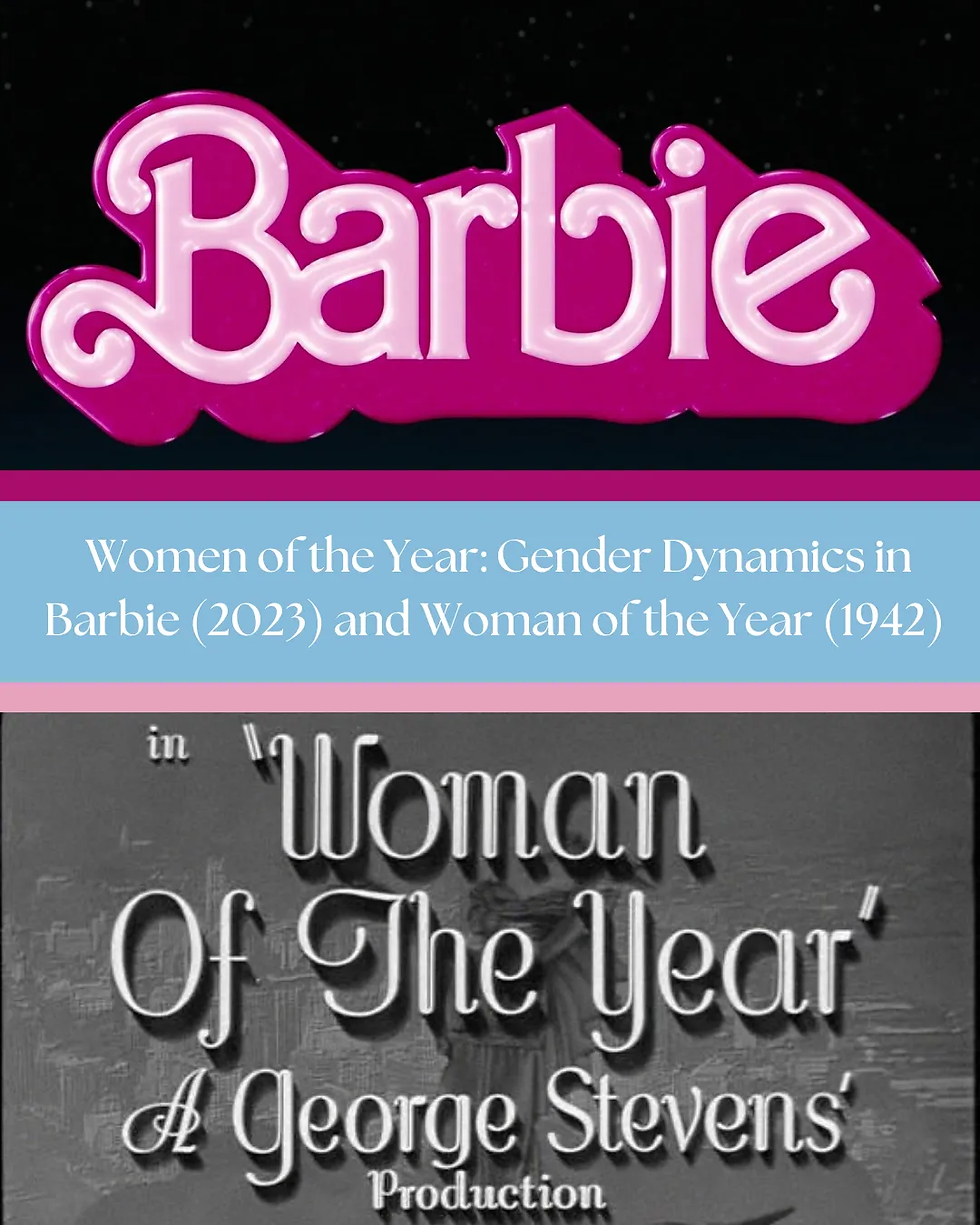
The release of Barbie in 2023 marked a milestone for women filmmakers, as Greta Gerwig became the first solo female director to release a film grossing over one billion dollars. Gerwig successfully transformed a pop culture figure into a blockbuster hit that both revitalized the movie-going experience and tackled social and gender dynamics. In crafting the distinctive world of Barbie, Gerwig emphasized the importance of revisiting classic Hollywood films to inspire her cast and crew. In an interview during her press tour with Turner Classic Movies, Gerwig discussed how immersing herself in film history bolstered her perspective as a director:
“It’s important to continually engage in the history of movies and cinema because it’s always a reminder that movies can be anything. Every one of these [filmmakers] are both responding to film history and then also inventing again.”
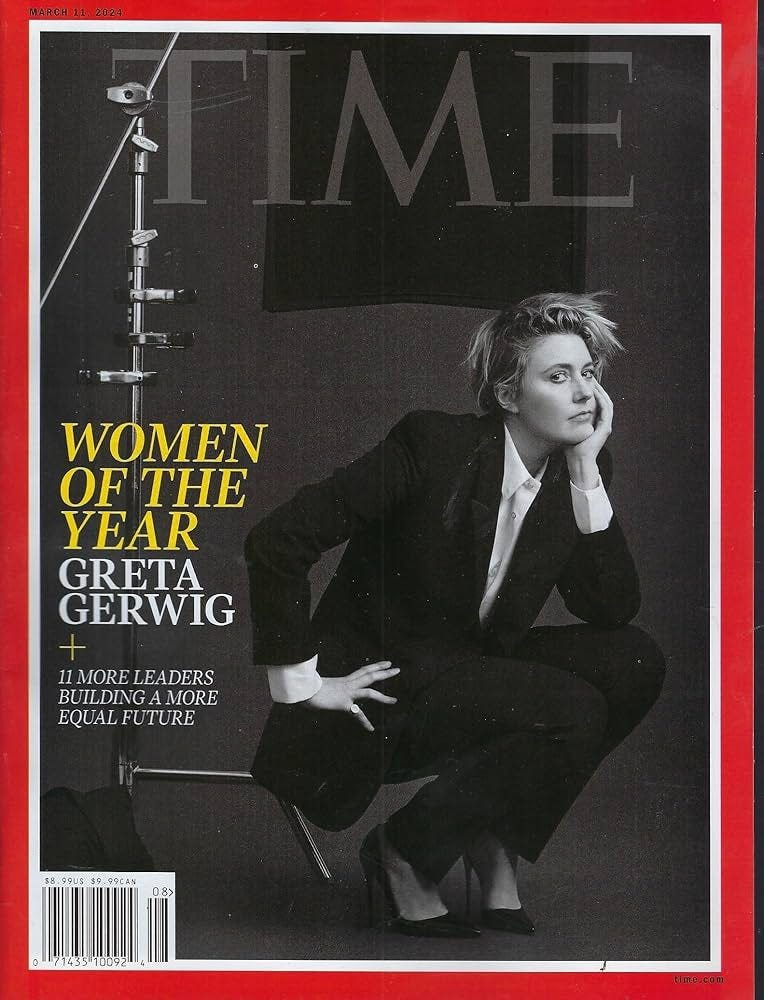
With an appreciation for film history, Gerwig balances both paying tribute and responding to the films of the past that have tackled the topics of womanhood, gender dynamics, and self-discovery. In crafting the character of Barbie, Gerwig and Margot Robbie specifically looked upon the work of four-time Oscar winner Katherine Hepburn.

One of the first actresses in Hollywood to break gender boundaries by wearing… wait for it… pants, Hepburn was a trailblazer both on and off the screen. In the 1942 comedy Woman of the Year, directed by George Stevens, Hepburn plays a fictionalized feminist icon Tess Harding, who emulates everything Barbie is supposed to represent: a successful, independent, and intelligent woman. However, when Tess falls in love with sports reporter Sam Craig, played by Hepburn’s off-screen lover Spencer Tracy, she struggles to break out of her perfect mold and show her vulnerable side.
Despite occupying two completely different worlds, Barbie and Tess follow a similar journey of learning to embrace their imperfections in order to rediscover their sense of self. Through their comedic yet heartfelt directing styles, Greta Gerwig and George Stevens reflect upon the societal pressures placed upon women and men and engage in a conversation on what it means to be human.
Woman of the Year opens with a classic title sequence of newspaper headlines displaying Tess’s name in a large, bold font. As with Barbie, Tess’s name is known all around the world. As a top-notch international journalist, Tess exhibits confidence, respect, and power during a time when women’s rights were limited. Living independently in her dream New York City penthouse, wearing stylish clothing, and working as a multi-hyphenate journalist-humanitarian-advocate, Tess mirrors the life of Barbie. She has constructed a picture-perfect life and defies traditional feminine stereotypes by doing everything and anything she desires.
What enables both Tess and Barbie to uphold a strong sense of confidence and an illusion of perfectionism is their lack of self-awareness, which consequently makes them seem unreal and emotionally disconnected from the rest of the world. In representing these strong-willed characters, Robbie and Hepburn both hold themselves with an extreme self-assuredness and stubbornness, which masks any sign of insecurity within their characters.
BARBIE
“It is the best day ever, and so is yesterday, and so is tomorrow, and so is the day after tomorrow, and even Wednesdays and every day from now until forever!”
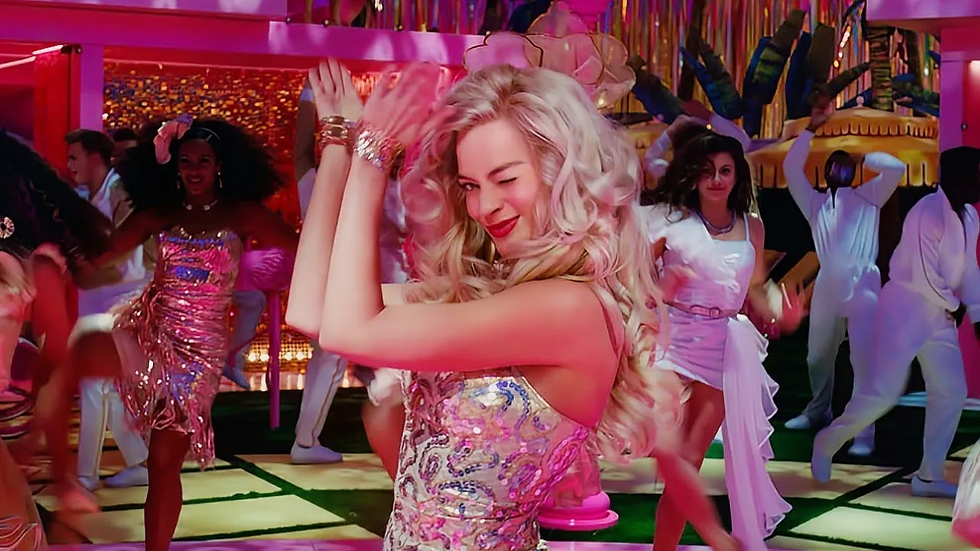
With no sense of their flaws or how their behavior affects others, Barbie and Tess are free from any self-criticism. However, while their perfection protects them from the pain of self-doubt, Tess and Barbie eventually realize how their “perfect” lives are lonely.
AUNT ELLEN (Fay Bainter)
“You can’t live alone in this world, Tess. It’s no good. Success is no fun unless you share it with someone."
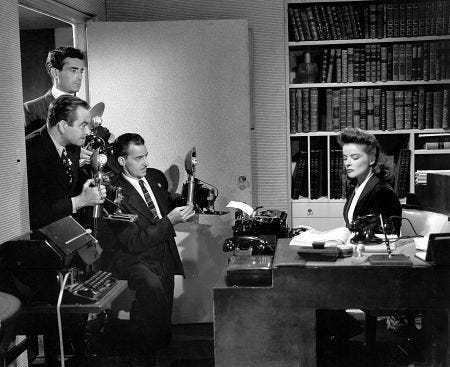
When Barbie’s pink world is interrupted by her dark thoughts of death and the emergence of cellulite, she realizes she has no one she can speak to about her fears since everything in her world is meant to be perfect. As a result, she embarks on an adventure into the real world, where she hopes to find quick answers to her problems. Instead, she witnesses the complicated nature of reality and finds people who embrace and understand her insecurities. For instance, sitting outside a bus stop, Barbie encounters an old lady who contains all the features she fears, wrinkles and grey hair. However, when she looks at the woman, she smiles and witnesses the beauty and confidence of the old lady despite her “imperfections.”
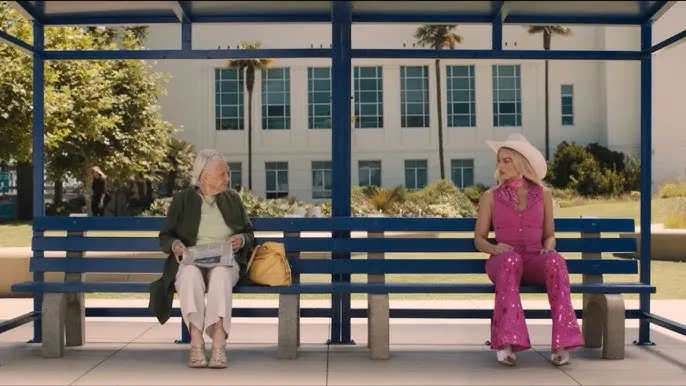
On the other hand, Tess’s growth comes with learning to fall in love and to become a supportive partner. When Tess has no one by her side when she receives the Woman of the Year award, she feels the pang of loneliness and realizes how she has driven the people she loves out of her life by prioritizing her perfection. In becoming self-aware and relinquishing the pressure of being perfect, both characters break out of their molds and discover what they value in their lives. Although both Barbie and Tess are fictional characters, they represent the real societal pressure women face as they strive for perfection to gain respect. Gerwig and Stevens highlight through these characters’ arcs how the pursuit of perfection strips women of a sense of selfhood and an opportunity to be human.
While developing Barbie, Gerwig listed directors of screwball and romantic comedies from the 1930s and 1940s as key inspirations. In the Golden Age of Hollywood, comedy served as a vessel to satirize and criticize societal standards while also entertaining audiences by creating over-the-top situations. One comedic device that Gerwig incorporates in her film, which also appears in Woman of the Year, is the gender role reversal. Gerwig and Stevens both criticize the constraining nature of gender and explore the vulnerability of their male characters by placing them in the shoes of women.
In Woman of the Year, Stevens immediately communicates the reversed power dynamics between Sam and Tess through the structure of their work environments. Sam works on the bottom floor while Tess has her own office on the top floor with a secretary. Later, in the film, Sam exhibits the stereotypical qualities often associated with the female leads in romantic comedies. From making breakfast to fussing over his appearance, Sam acts as a foil to Tess, whose obsession with her career causes her to dismiss and condescend to Sam. Following a similar reversal in Barbieland, the women hold the dominant power, and the Kens serve as second-rate citizens, only seen as accessories to the Barbies. While the Barbies work as doctors, lawyers, and award-winning authors, the Kens’ only job is to “just beach.”
NARRATOR
“Barbie has a great day every day, but Ken only has a great day if Barbie looks at him.”
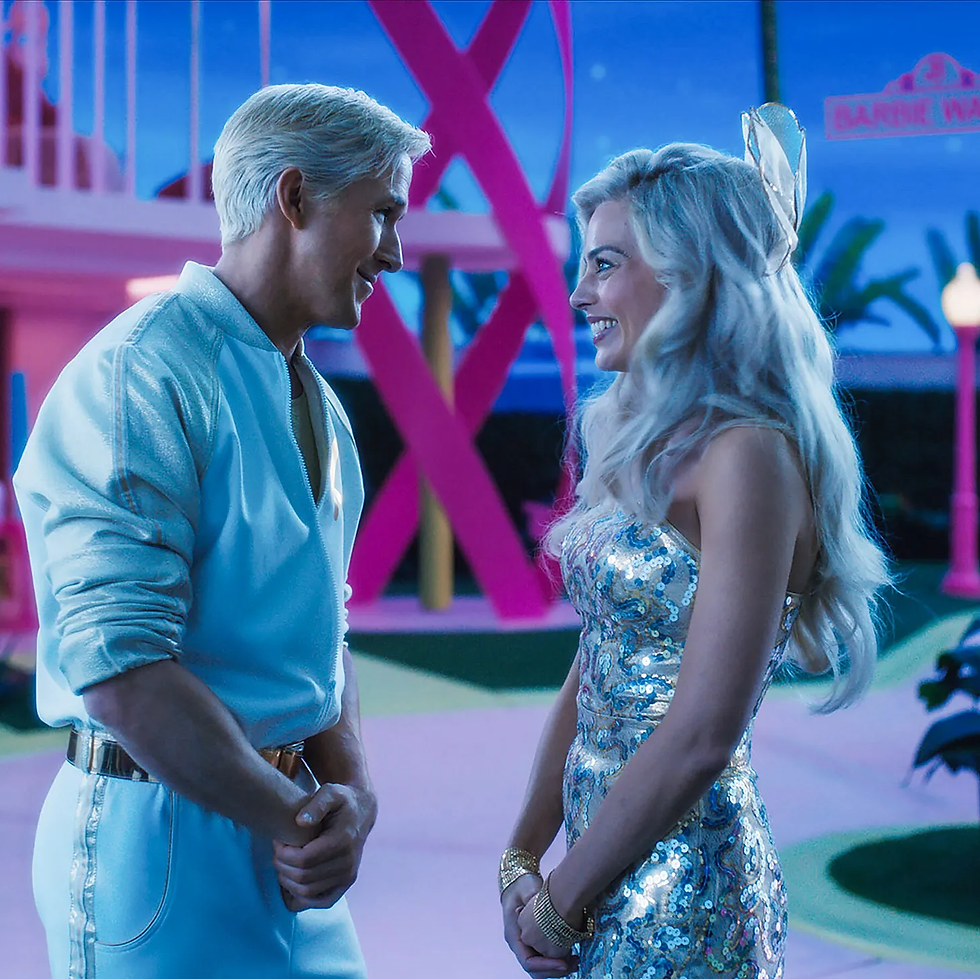
When Sam marries Tess, he hopes she will stop obsessing over her career and commit to their relationship. However, he becomes frustrated when Tess struggles to follow the traditional responsibilities of a wife, such as welcoming him home with dinner or taking care of their adopted child. Instead, these expectations fall on his shoulders, causing him to feel disrespected and emasculated. However, during a conversation with Tess’s father, Sam realizes that the puzzle piece missing from his marriage is not his dominance, but rather a sense of equality, as Mr. Harding (Minor Watson) explains:
“You go home to someone. Someone to talk to, to live with, to share each other’s work and ideas…That other person existing who cares as much about your interests as you do.”

Similarly, after witnessing the inner workings of the patriarchy in the real world, Ken originally believes the solution to his frustration with Barbieland is to brainwash the Barbies and introduce patriarchy in their world. Nonetheless, once Ken creates his perfect mojo dojo casa house, he still feels empty inside and not “kenough” for Barbie. Both Sam and Ken come to realize that they don’t want to assert power in their partnership but rather want to feel seen and appreciated.
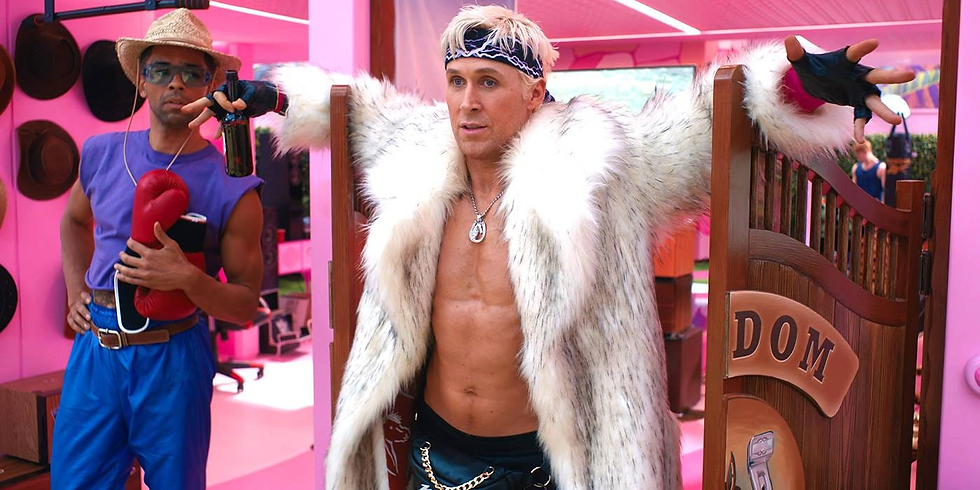
Although the censorship placed on Hollywood films in the 1940s by the Hays Code prevented Stevens from presenting as bold of a message on gender relations as Gerwig did, the ending of Woman of the Year communicates a subtle yet powerful take on the relationship between men and women. To save their marriage and prove her commitment to their relationship, Tess sneaks into Sam’s apartment and attempts to cook him breakfast. However, Tess struggles as the toast flies everywhere, the coffee boils over the stove, and the waffles rise to the ceiling. In her desperation, Tess, almost out of character, promises to quit her job and become a housewife for Sam. Instead of celebrating Tess’s submission, Sam chides her for the foolish remark and explains:
“I don’t want to be married to Tess Harding any more than I want you to be just Mrs. Sam Craig. Why can’t you be Tess Harding Craig?”

Sam does not want Tess to quit her job and abandon her identity to appease him. Instead, he wants them to be partners who equally care about each other.
Gerwig builds upon this message of creating a balanced relationship between men and women through a more modern and less romantic perspective.
After the Barbies successfully stop the Kens’ patriarchal revolution, Barbie apologizes for her mistreatment of Ken and helps him process his insecurities. Rather than indulging in his romantic fantasies, she encourages him to find his sense of identity instead of defining his worth based on her or what society tells him to be:
KEN
“It’s Barbie and Ken. There is no just Ken. I only exist within the warmth of your gaze.”
BARBIE
“Maybe it’s time to discover who Ken is. You have to figure who you are without me…Maybe it’s Barbie and it’s Ken.”

The representation of women on the silver screen has evolved and changed over the decades with cultural and political shifts in society. From the damsel in distress to the femme fatale to the diva, women characters are often subjugated to societal stereotypes, which make them seem one-dimensional and flat. However, Gerwig and Stevens highlight how, through comedy, filmmakers can confront, satirize, and undermine societal stereotypes. Despite the 80-year gap between their films, Gerwig and Stevens share a common goal of using their stories to uncover the humanity of their characters, away from social standards. Incorporating elements of classic Hollywood comedies, from the fast-paced dialogue to quirky characters, Gerwig pays homage to comedies like Woman of the Year, while simultaneously bringing forth a fresh new perspective, which builds upon and modernizes the genre through her distinctive voice.




